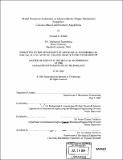Model parameter estimation of atherosclerotic plaque mechanical properties : calculus-based and heuristic algorithms
Author(s)
Khalil, Ahmad S. (Ahmad Samir), 1980-
DownloadFull printable version (11.12Mb)
Other Contributors
Massachusetts Institute of Technology. Dept. of Mechanical Engineering.
Advisor
Mohammad R. Kaazempur-Mofrad and Roger Kamm.
Terms of use
Metadata
Show full item recordAbstract
A sufficient understanding of the pathology that leads to cardiovascular disease is currently deficient. Atherosclerosis is a complex disease that is believed to be initiated and promoted by linked biochemical and biomechanical pathways. This thesis focuses on studying plaque biomechanics because (i) there is a dearth of data on the mechanical behavior of soft arterial tissue yet (ii) it is the biomechanics that is able to provide invaluable insight into patient-specific disease evolution and plaque vulnerability. Arterial elasticity reconstruction is a venture that combines imaging, elastography, and computational modeling in an effort to build maps of an artery's material properties, ultimately to identify plaques exhibiting stress concentrations and to pinpoint rupture-prone locales. The inverse elasticity problem was explored extensively and two solution methods are demonstrated. The first is a version of the traditional linear perturbation Gauss-Newton method, which contingent on an appropriate regularization scheme, was able to reconstruct both homogeneous and inhomogeneous distributions including hard and spatially continuous inclusions. The second was an attempt to tackle the inherent and problem-specific limitations associated with such gradient-based searches. With a model reduction of the discrete elasticity parameters into lumped values, such as the plaque components, more robust and adaptive strategies become feasible. A novel combined finite element modeling-genetic algorithm system was implemented that is easily implemented, manages multiple regions of far-reaching modulus, is globally convergent, shows immunity to ill-conditioning, and is expandable to more complex material models (cont.) and geometries. The implementation of both provides flexibility in the endeavor of arterial elasticity reconstruction as well as potential complementary and joint efforts.
Description
Thesis (S.M.)--Massachusetts Institute of Technology, Dept. of Mechanical Engineering, 2004. Includes bibliographical references (p. 123-133).
Date issued
2004Department
Massachusetts Institute of Technology. Department of Mechanical EngineeringPublisher
Massachusetts Institute of Technology
Keywords
Mechanical Engineering.